25-minute read
Dermot Feenan
LLB MA LLM Barrister-at-Law (non-practising) FRSA
Introduction
Reckoning with the history of transatlantic slavery has been one of the defining issues in Britain since the Black Lives Matter protests in the long, hot summer of 2020. The toppling of the statue of slave trader and Tory MP Edward Colston from his plinth in a leafy square in Bristol into the city’s harbour was perhaps the most potent among those protests.
The protest led to calls for statues of others directly involved in Britain’s colonialism and slave trade to be removed. In response, the Conservative government led by Prime Minister Boris Johnson announced the introduction of new law to protect historic statues, plaques and monuments, including a requirement that they should be ‘retained and explained’.
Disputes over how to deal with Britain’s history of colonisation and slavery have become a frontline in the so-called ‘culture wars’, driven largely by those on the political right – whose targets include one of the country’s leading heritage bodies, the National Trust, largely due to its publication in September 2020 of a report on the connections between its properties and colonialism, including links with historic slavery. The Trust acknowledged in that report its ‘commitment to research, interpret and share the histories of slavery and the legacies of colonialism at the places we care for’.
A year on from the protest in Bristol, Colston’s statue, retrieved from its watery repose, is now displayed in an ignominious supine position in one of the city’s museums as part of a consultation on its future. The museum states: ‘this temporary display is the start of a conversation’.
Soon after, I am standing in front of a large portrait of a man in Petworth House, a National Trust property in southern England regarded as having one of the finest collections of art in a publicly accessible house in the UK.
The man is bewigged and lavishly dressed in velvet and silk, like many portraits of the aristocracy in the seventeenth century. He looks straight out from the painting at the viewer. He seems haughty. In the lower right-hand corner of the painting is a Black boy, holding a plumed hat and looking up at the man’s extended left hand.
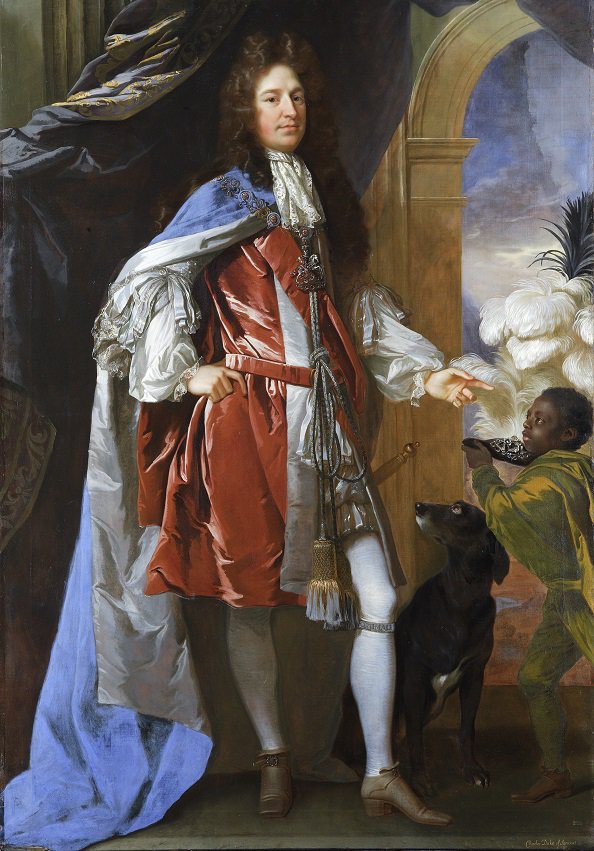
I am curious to place the painting historically because I have recently been researching slavery and colonialism, and am aware of the role of some members of the aristocracy in the slave trade in England. I turn to the Room Guide, one of the many volunteers used by the Trust to explain their collections, and ask: ‘When was this painted?’
‘1660, I think’, she replies.
‘It’s Charles Seymour, the 6th Duke of Somerset. He married into wealth’, she adds, gesturing towards an adjacent full-length portrait. ‘Elizabeth Percy. They made a good match’. As I ponder what ‘a good match’ means, she leafs through a guide and checks the listing for the painting. Placing her pale white forefinger on a page, she states: ‘1690. It was painted in 1690.’
Throughout the extended reply she does not refer to the Black boy. Intrigued, I check the National Trust’s online listing for the painting when I return home. It lists it as ‘Charles Seymour, 6th Duke of Somerset KG (1662-1748) and a Page’. Even the Trust’s official record referred to the page. The Room Guide’s omission of that fact is significant. Yet, the page is also Black – conspicuous among the gallery of white faces elsewhere in the collection.
Increasing public knowledge of the legacy of colonialism and slavery in Britain means that Black presence in historical paintings may very well require explanation by heritage guides. Indeed, the Trust uses the subject ‘Black presence’ in categorising its collection.
In the wake of the convulsions of Black Lives Matter protests and the Trust’s own commitment, how is it possible in proffering a description of the subject of a painting when unsolicited to omit mentioning the obvious and only Black person in that image? Thinking about the Tory government’s reactive intervention, how is it possible to retain and explain heritage when significant parts of history are omitted in the very act of explanation?
The omission of reference to the Black page is not, apparently, isolated at the Trust.
In a recent article titled ‘Britain’s Idyllic Country Houses Reveal a Darker History’, Sam Knight, the author, reports on a similar episode at one of the Trust’s properties, Dyrham Park, approximately ten miles as the crow flies from Bristol. Knight recounts that Shawn Sobers and another member of the Bath Ethnic Minority Senior Citizens Association were asked by the Trust to bring racially diverse groups to three of its properties in the southwest of England, where they explored the visitors’ reactions, as part of a series of projects to mark the bicentenary in 2007 of the abolition of the slave trade in Britain.
The Association visited Dyrham Park, which contains slave stands (one of which is shown below).
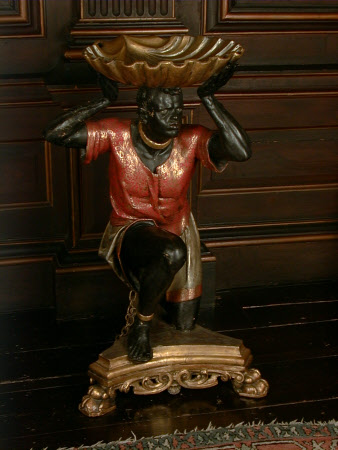
Knight continues: ‘[T]hey [the group of invited visitors] came face to face with the slave stands and stood there, listening politely. “I couldn’t believe it. I really couldn’t believe it was happening,” Sobers told me. “And the tour guide talked about every single thing in that room, you know, talked about everything for a good ten, fifteen minutes and not once mentioned it.’
These omissions may seem odd given the significant level of media attention given to transatlantic slavery. In 2007, there was considerable coverage of the bicentenary across TV and radio, print media, and then fast-growing digital platforms. There was even more attention given to slavery following the Black Lives Matter protests in 2020, with significant coverage during the latter half of 2020 of the Trust’s position on colonialism and slavery.
The omissions may be explicable, however, in terms of the ongoing difficulty for some in the United Kingdom, but especially in England, to fully grasp the country’s role, including of its monarchy and aristocracy, in slavery. This difficulty persists due to the myths that some individuals and groups in England still hold about slavery: the self-valorising story that the country brought slavery to an end (without acknowledging that it was one of the biggest slave traders and secured political approval for the abolition of slavery only by paying off the slave owners or direct beneficiaries of slavery, without paying a single penny in compensation to enslaved people). The difficulty also persists in the conceit, kept alive by an activist minority on the political right, that transatlantic slavery has no significance for the present and should not be addressed.
In order to make sense of these omissions, it’s necessary to fully analyse that portrait of Charles Seymour and its representation of the Black page, and to seek to place it within a genre of European painting between the late-sixteenth and late-eighteenth century in which the Black attendant featured.
The presence of the Black attendant in painting across those two centuries also helps understand part of the process by which racialisation emerged, developed and was reinforced. That racialisation involves, still, the assumption of white dominance over the Black body.
Can the government’s policy to retain and explain heritage even be successful when significant parts of history are omitted in the very act of explanation and part of that omission derives from the reluctance of those on the hard right, some of whom sit in government, and those who may be swayed by them, to fully acknowledge the history and ongoing legacy of colonialism and slavery?
Charles Seymour and that page
The portrait of Charles Seymour was completed around 1690—1692. Almost everything about the painting announces status, that which already exists and that which is further desired. It hangs adjacent to a full-length portrait of Henry VIII from the studio of Hans Holbein. The portrait of the late King sits squarely in the most prominent position in the room, itself the most prominent room in the house. By placing his portrait near Henry, even though the King died in 1547, Seymour may have wished to be seen as close to top of the social class hierarchy of England as possible. It is perhaps unsurprising then that the painting sits in a space specially created within what has become known as the ‘Carved Room’, a space containing the finest wood carvings anywhere by Grinling Gibbons, called ‘The King’s Carver’ due to commissions from Charles II. Before Seymour’s portrait was completed, Gibbons held royal commissions such as at Windsor Castle and from the aristocracy, including at Cassiobury House, the ancestral home of the Earls of Essex.
Seymour’s apparent desire to place himself close to the Crown either by association or by imitating its practices seems to be echoed in his choice of painter: John Closterman. Closterman had worked in the studio of John Riley – portrait painter to Charles II, James II, and William III and Mary II. Riley reputedly allowed him to finish the fabrics in his royal commissions. When Riley died in 1691, Closterman also completed a number of Riley’s paintings.
Seymour was called the ‘Proud Duke’ due to his vanity and arrogance. Indeed, such was his self-regard that the writer and Whig politician Thomas Babington Macaulay described him in The History of England as ‘a man in whom the pride of birth and rank amounted almost to a disease’.
Between 1688 and 1702, Seymour had Petworth rebuilt in the style of the Palace of Versailles under Louis XIV, whose reign is regarded as emblematic of absolute monarchy. By then an increasing number of royals and aristocrats in England and in continental Europe were painted with the novel inclusion of a Black attendant. Did Seymour conceive of the portrait by Closterman, including its size, his posture and the presence of the Black page with reference to how it would fit within this overall display of wealth, status and affinity? In order to answer this, it will also be helpful to examine further the context in which the presence of a Black boy in such a painting could effect such communicative power.
Presence and context: overview
By the end of the sixteenth century it had become fashionable among the aristocracy in England to have a Black houseboy, as noted by Professor David Dabydeen in his 1985 book Hogarth’s Blacks: Images of Blacks in Eighteenth Century English Art.
The practice extended throughout Europe. An early example is the painting by Cristóvão de Morais, Portrait of Joanna of Austria (1535-1573), daughter of Charles V, circa 1551-1552 (below).
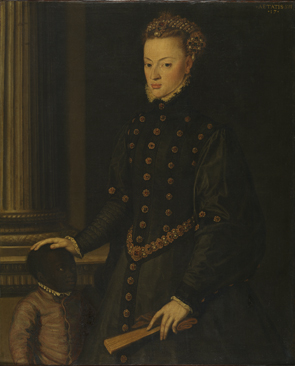
In the first half of the seventeenth century Black attendants began to feature increasingly in paintings, including of royalty – as illustrated in Paul Van Somer’s Anne of Denmark (1574-1619) and a Groom, 1617 (below).
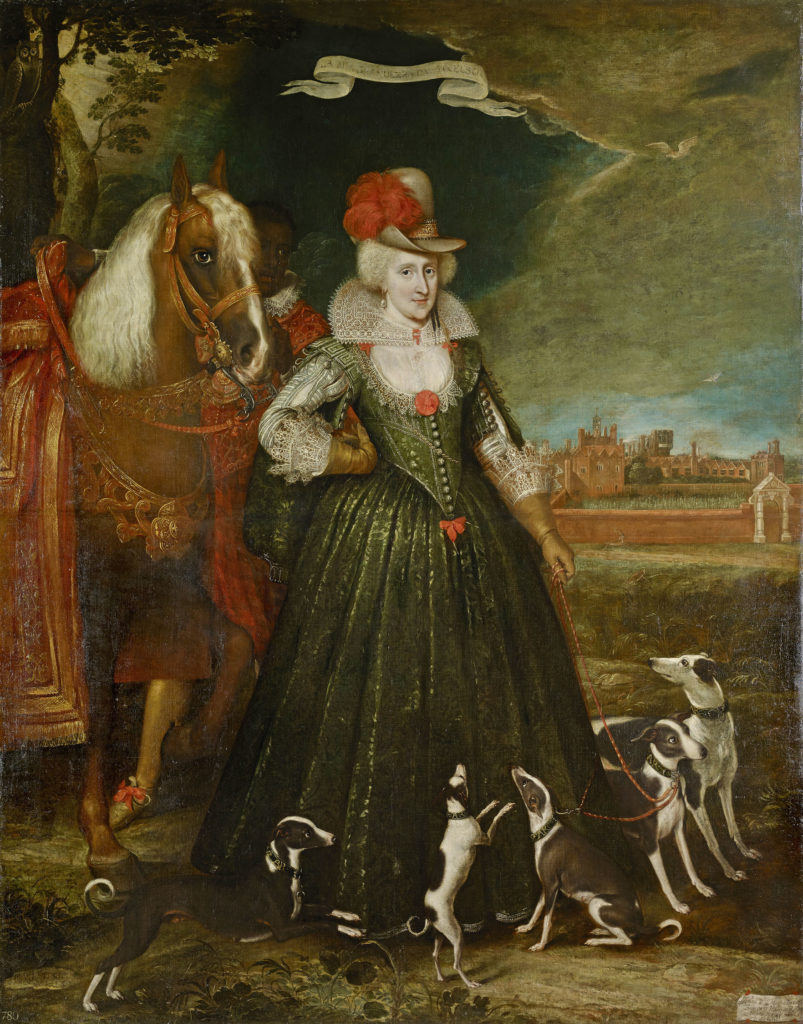
After 1660, a significant change becomes obvious in the depiction of the Black attendants. They are shown wearing metal collars. Some of these images are held by the National Trust. They include The Hon. Anne Coventry, Lady William Savile, later Lady Thomas Chicheley (d. 1662) and Page, attributed to John Hayls, 1660, held in Lyme, Cheshire, and Sir Godfrey Kneller’s Captain Thomas Lucy (circa 1655-1684) and an unidentified groom, 1680, held at Charlecote Park (both set out below). The collar indicated enslavement.
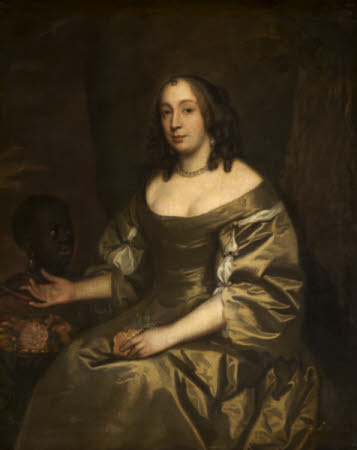
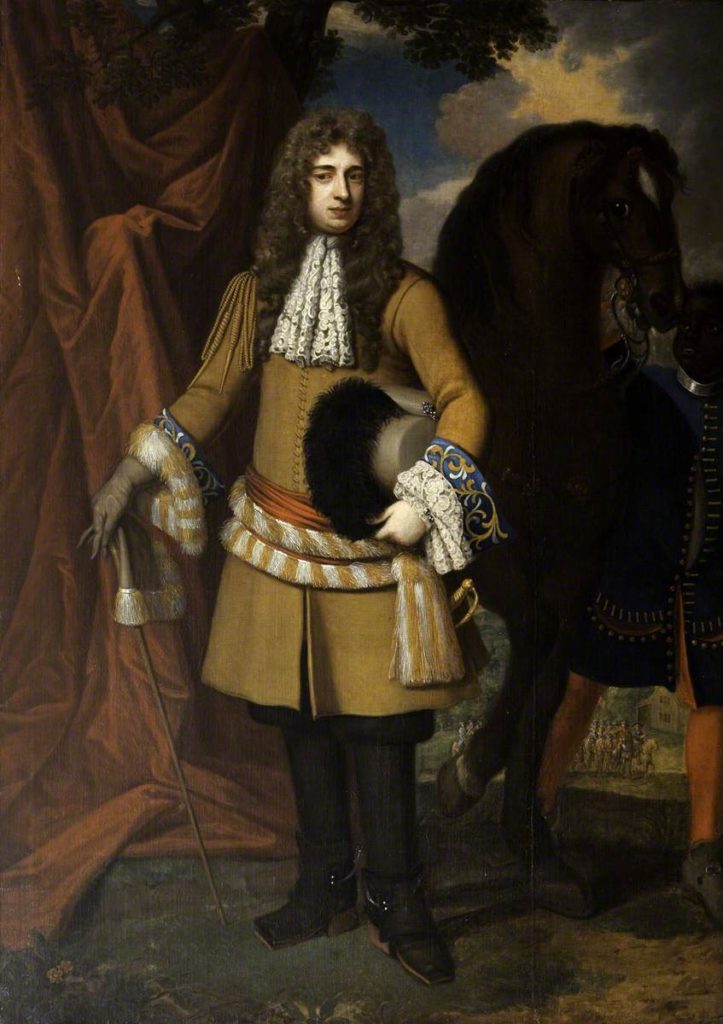
In another painting in the Trust’s collection, Princess Henrietta Anne Stuart, Duchess of Orléans (‘Minette’) (1644–1670) and an Attendant, after Jean Charles Nocret, the younger, 1700-1799, Dunham Massey, Cheshire, Princess Henrietta holds a portrait of her husband. In the lower left corner of the painting a small Black figure holds a corner of the portrait. That figure is wearing a slave collar.
Princess Henrietta was the youngest daughter of Charles I. Smuggled out of England after the imprisonment of her father in 1646, she grew up in the French court and married Philip, Duke of Orleans, brother of Louis XIV in 1661.
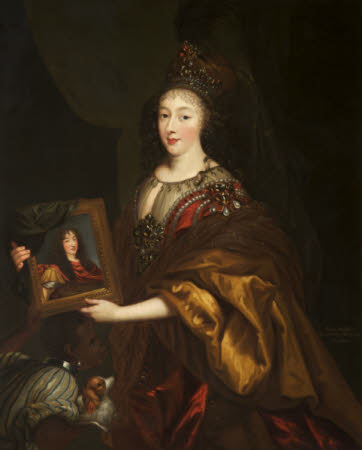
Throughout the period in which the painting is believed to have been painted, France was a leading country in the transatlantic slave trade, third only to England and Portugal, with 1,381,000 Africans loaded onto French ships to be taken to France’s Caribbean colonies such as Saint-Domingue and Martinique.
Dr Emma Poulter (as she then was), principal researcher on Revealing Histories: Remembering Slavery, the project to commemorate the bicentenary of the abolition of the British slave trade in 1807, wrote that Black attendants ‘were seen as markers of wealth, status and refinement. In this way slavery was domesticated in aristocratic circles’.
The Black servant was also a ‘novelty’ and signifier of the owner’s connection to the ‘exotic’ in Britain’s emerging Empire. In 1662, Samuel Pepys, the seventeenth-century diarist, records that upon a visit to greet the Earl of Sandwich on his ship after a voyage back from abroad on government business, he saw ‘a little Turk and a negroe’ intended as pages for the Earl’s daughters, plus ‘[m]any birds and other pretty noveltys’.
In addition, the presence of a Black attendant imported, as Adrienne L. Childs notes, ‘notions of an imperial economy and mercantile wealth’ – illustrated in Pierre Mignard’s Portrait of Louise de Kéroualle, Duchess of Portsmouth, 1682. There, the Black attendant wears a strand of pearls while holding in one hand a large seashell filled with pearls and in the other a piece of red coral. Shown in the distance—not the usual wooded landscape, but the open sea.
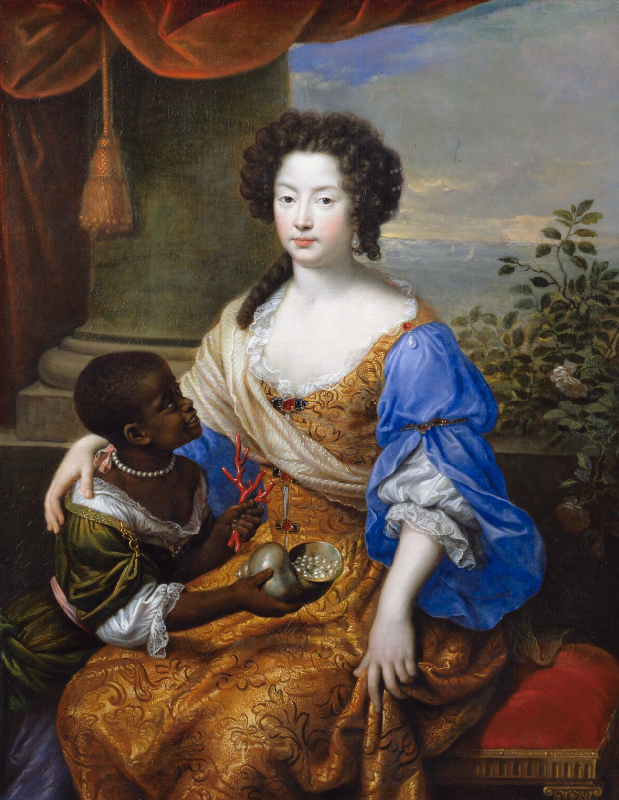
The darkness of the Black child’s skin served as foil to the conspicuously white skin of the aristocracy, which, at the time, signified higher social status. The representation of the enslaved Black presence also becomes, as Agnes Lugo-Ortiz and the late Angela Rosenthal note, ‘a constitutive component of white identity’ (p. 4).
Much is made in some commentary on the images in terms of fashion, status, wealth, and novelty, but fewer commentators examine critically the economic, political and cultural context within which these mattered, still less analyse the significance of the Black person in the paintings as a key part in the creation, development and reinforcement of a process of racialisation.
The Black attendant in the painting of Charles Seymour at Petworth House draws from this context.
Context: slavery – a closer look
Over a period of 300 years from the mid-sixteenth century, almost every European country and the American colonies were involved at some stage and to varying degrees in the transatlantic slave trade. The scale of this slavery from Africa to European colonies in the Americas was unprecedented, estimated at 12,231,603 slaves between 1551 and 1850. In England, Queen Elizabeth I, who reigned 1558-1603, granted John Hawkins a commission which allowed him to privateer. Forming a venture syndicate which included an admiral in the Navy, a merchant venturer, and the Lord Mayor of London, he led three ships to Sierra Leone where they captured 300 slaves and sold them in the Americas. Following further such voyages, in 1565, Elizabeth granted Hawkins a coat of arms which includes a male slave, described in the peculiar language of heraldry as ‘a demi Moor in his proper colour, bound and captive, with annulets in his arms and ears, or’.
In 1660, the Royal African Company was established by the royal Stuart family and wealthy merchants in the City of London to trade in slaves from West Africa. In the 92 years of its existence, it traded more slaves from Africa than any other company. Investors in the Company included royalty and the aristocracy. Its largest shareholder was James Stuart, the future king. Other notable investors in the Royal African Company were Charles II and Prince Rupert, Duke of Cumberland; Henry Bennet, 1st Earl of Arlington; George Villiers, 2nd Duke of Buckingham; Anthony Ashley Cooper, 1st Earl of Shaftesbury; William Craven, 1st Earl of Craven; Sir John Shaw, 1st Baronet, and; Sir Robert Vyner, 1st Baronet.
The British Crown’s investment in slavery continued under Queen Anne, who reigned 1702-1714. She secured an exclusive contract to provide enslaved Africans for the Spanish West Indies for thirty years. The British government sold the contract to the newly formed South Sea Company for £7.5 million. Queen Anne was allocated 22.5 per cent of the company’s stock. When she died in 1714, her successor, George I, inherited her shares and bought more shares in the company. His heir, the Prince of Wales, was also an investor and became a governor of the company in 1715 when his father became king on Queen Anne’s death. In 1718, George I made himself governor.
The wealth generated for royalty and the aristocracy from slavery was considerable, and, in the early period of transatlantic slavery, accounts, in part, for the presence of the Black attendant in paintings of the time.
If the presence of the Black attendant as novelty became a feature in some paintings of royalty and the aristocracy in the sixteenth century onwards, the increase in the slave trade in the ensuing few centuries and the tendency among some other classes to mimic such features led to a proliferation of the Black attendant in painting.
The painting of Elihu Yale with Members of his Family and an Enslaved Child, circa 1719 – 1721 (formerly Elihu Yale, The 2nd Duke Of Devonshire, and Lord James Cavendish), attributed to John Verelst, is telling.
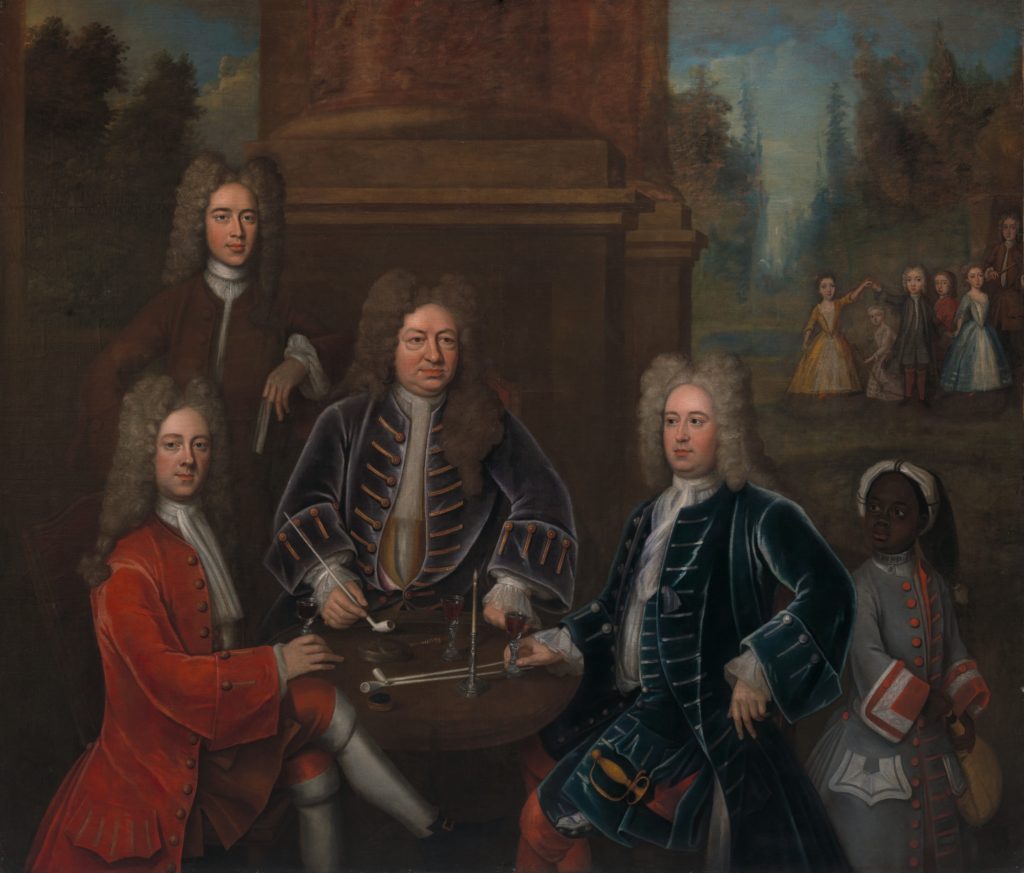
In the image, Yale sits centre at a table, as though holding court, with two men. To his left, Dudley North, of Glemham Hall, Suffolk; son of a wealthy merchant, educated at Cambridge, and a member of the House of Commons. The figure to his left is not definitively known. One interpretation is that it is Lord James Cavendish, who married Yale’s daughter Anne in 1708. As part of the dowry, Yale gave £8,000 worth in jewels (over a million pounds today).
To the right of the men and turned slightly away towards the edge of the painting is a Black boy, dressed in fine clothes. He carries a bottle of wine. Around his neck: a slave collar, with lock. Given the setting and background, the painting was most likely set at Chatsworth House, ancestral home of the Devonshire family. There is no definite record currently in the public domain which reveals whether the enslaved attendant belonged to the family or Yale. However, Yale University Art Gallery holds another painting of Yale which depicts and specifically refers to Yale’s ‘servant’ – a young Black boy, with slave collar – not unlike the boy in the painting with Devonshire.
The painting of Yale with his family and an enslaved child is partly about commodities that ensure the wealth of Yale and others: the tobacco, the cotton and, of course, the slave. Yale’s prominence in the painting also denotes a shifting of class relations, from the dominance of the aristocracy to the emergent power of a new mercantile class. Yale’s connection with the aristocracy through marriage made the presence of the Black slave in the portrait doubly significant. Yale’s wealth and power was based in part on colonial trade, including slavery. The Black slave underscored that wealth and power. The Black slave’s presence also imitated the presence of the Black slave in earlier images of royalty and the aristocracy, but note that in this image there are now four white men, not simply a portrait of a royal or an aristocrat. The painting also speaks of shifting relations between social classes.
Yale had generated his considerable wealth as a leading figure in the East India Company. The Company was established as an English (then British) joint-stock company in 1600 to trade in the Indian Ocean region. It seized control of much of the Indian subcontinent, colonised parts of Southeast Asia and Hong Kong, and created colonial outposts in the Persian Gulf Residencies. The Company traded in slaves, as noted by Richard B. Allen in his book European Slave Trading in the Indian Ocean, 1500-1850; which covered the time that Yale worked in India, including in the influential position as President of Fort St George, the company’s post in Madras (now Chennai).
Yale benefitted both directly and indirectly from this trade. The company rose to account for half of the world’s trade generally during the mid-1700s and early 1800s. Elsewhere across British and other European colonies slaves were integral to the production of commodities such as coffee, cotton, rum, sugar and tobacco for a rapidly increasing consumer market. The wealth generated contributed to further colonial expansion, and a concomitant increase in the slave trade which enriched and enhanced the status of a new landowning class, merchants, and senior military and naval figures.
The English were, however, slow to take up the slave trade compared to Portugal, Spain and the Dutch Republic. The Dutch East India Company, founded in 1602, landed its first shiploads of slaves at the Cape on the southern tip of Africa in 1658: 200 from Dahomey, 200 captured from a Portuguese slaver. In 1630, the Dutch Republic successfully invaded the Portuguese-controlled state of Pernambuco in Brazil – then the largest and most profitable sugar-producing area in the world. The Dutch traded to and from their own colonies in New Amsterdam, South America and the Caribbean but also sold to other colonies.
In 1666, Pieter Nason completed a portrait of Johan Maurits of Nassau-Siegen (below). Murits had distinguished himself in the Dutch army in European campaigns and was appointed as the governor of the Dutch possessions in Brazil. In the painting, a young Black attendant holds a map and, looking up at Murits, points at what may be the promontory on which Mauritsstad (or Mauritius), capital of Dutch Brazil, was built. The attendant wears a metallic collar.

The prevalence of paintings with young Black attendants wearing slave collars appears to increase in the eighteenth century.
Indeed, one such painting in the National Trust’s collection refers specifically in the title of the image to the enslaved status of the attendant, Mary Helden (1726 – 1766) and an Enslaved Child, painted by Charles Philips in London in 1739.
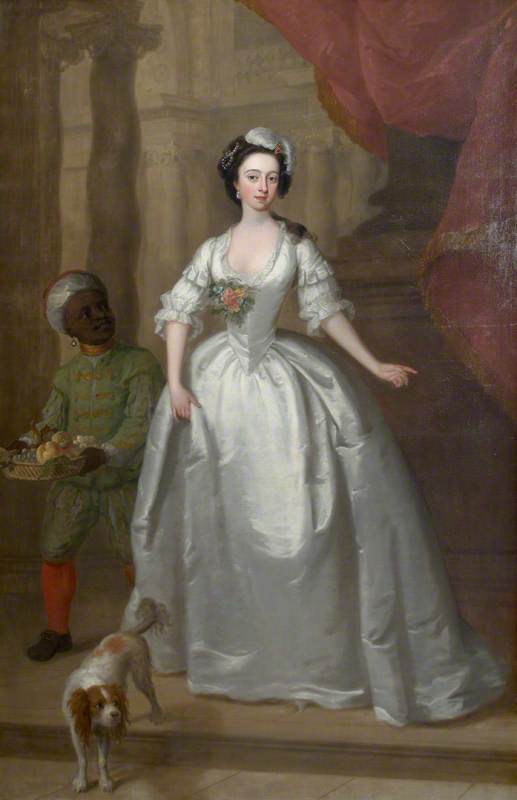
A similar collar is evident in another painting in the Trust’s collection, The Hon. Anne Howard, Lady Yonge (d. 1775) and a Page, painted by John Vanderbank the younger in 1737.
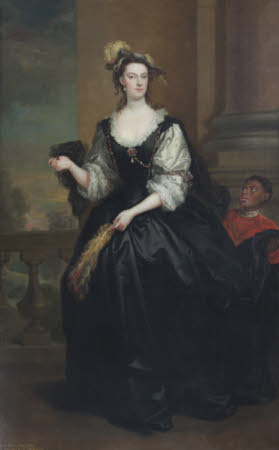
The latest such painting I have found of the Black attendant wearing a slave collar is dated 1750; the painting Landgravine Caroline of Hessen-Darmstadt by Antoine Pesne. A poor photo of the painting, with some light reflection, exists online; but it shows the collar clearly.

In each of these images with the Black attendant wearing a slave collar it is possible to see clear connections with the earlier images in which the Black attendant does not wear the slave collar: from the painting by Cristóvão de Morais, Portrait of Joanna of Austria (1535-1573), daughter of Charles V, circa 1551, through Closterman’s portrait of Charles Seymour, in 1690, to Pesne’s portrait in 1750.
The Black attendant is always in a servile role to a white person. In most of the paintings, he (though girls and women are sometimes portrayed) is placed at the edge and/or lower corner of the composition. Typically, the top of the head of the Black attendant never rises above the shoulders of principal sitter. Though dressed in lavish clothes, the attendant is blended into the background, though in some paintings – particularly with white women – the Black attendant’s skin is brought into prominent contrast with the white skin of the principal sitter(s). Many of the attendants are made to wear pearl earrings, which would have required puncturing of the earlobes. Some attendants are dressed in the peculiar turban that denotes their status as ‘Blackamoor’ – an othering technique using a distinctive European chimera that mixed ideas of the African, Arab and, in time, Oriental. In almost all of the paintings the Black attendant is made to look expectantly towards the white sitter(s) while the white sitter looks directly out at the viewer. A double effect is thereby achieved: to emphasise the importance of the principal sitter from two perspectives. This also denies agency to the Black attendant, who exists only as subservient to the white sitter, but both perspectives are racialised. The Black page looks admiringly at the white subject, and the viewer, assumed to be white since this was the target audience, is confirmed in the belief that this arrangement is obvious and natural. Uncomplaining, servile and sometimes adoring of the master, the Black attendant is infantilised.
As Professor Peter Erickson notes in his article ‘Invisibility Speaks: Servants and Portraits in Early Modern Visual Culture’: ‘Inclusion of the black servant does not represent benign inclusiveness but is rather keyed to incorporation into a visual regime structured in white dominance’ (p. 34). His point is well-illustrated in his discussion of van Dyck’s Princess Henrietta of Lorraine (1611–1660), Attended by a Page, completed in 1634 (below):
‘the servant’s job is to be as small as possible in deference to the women’s massive bearing. The reduction of his size is further accentuated by the disappearance of his left leg hidden out of sight behind the woman and by the white-on-black gesture of the large white hand, almost as big as his head, on his shoulder acting as a lever to control his forward motion and to hold him back. The servant’s function is not only to offer things but to become an appurtenance himself like the things he bestows.’
The painting was done at the court of Archduchess Isabella Clara Eugenia in Brussels, underscoring the ubiquity and geographical spread of such images in Europe.

This practice in portraiture was widespread. It is not correct to say, as the Katherine Betjaer, a curator emerita in the Department of European Paintings at The Met, New York, does that ‘[a] few 17th-century European portraits include slaves’. There were, as already shown, many such portraits. In addition to others shown above, there are similar portraits, including of members of the aristocracy in collections internationally. These include Françoise-Marie de Bourbon known as Mademoiselle de Blois and Louise-Françoise de Bourbon known as Mademoiselle de Nantes, completed in the final quarter of the seventeenth century by Philippe Vignon, in the Palace de Versailles; and Portrait of a Woman and an Enslaved Servant, 1696, by Nicolas de Largilliere, in The Met, New York.
These paintings are, however, only part of what becomes an increasing, then accelerating proliferation of images that subordinate the Black person, especially in the late-seventeenth century and in the eighteenth century. In 1708, the year that Elihu Yale celebrated the marriage of his daughter Anne to the 2nd Duke of Devonshire, Yale bought a sundial which comprised a sculpture of an African man on bended knee holding up the dial (below).
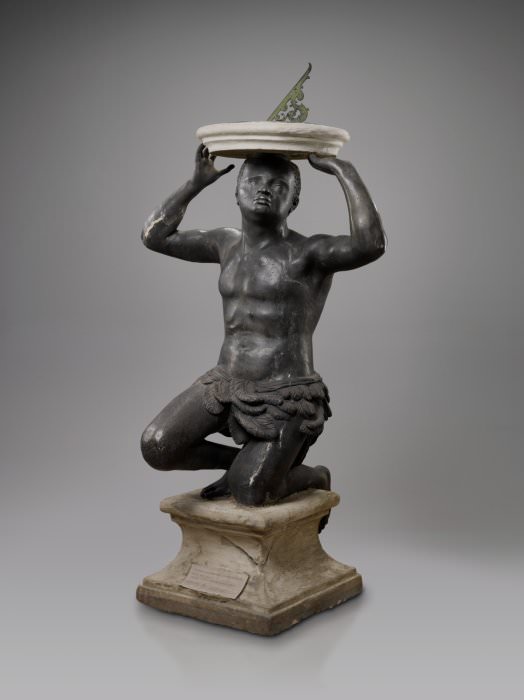
The sundial is one of many similar sundials produced chiefly by the sculptors John Nost and John Cheere to ornament English gardens in the early eighteenth century. Nost made the first of these for King William III’s Privy Garden at Hampton Court. The National Trust property Dunham Massey featured a similar sundial outside the front of the house for nearly 300 years until 2020, when it was removed pending a decision on its future, following the Black Lives Matter protests that summer. The Dunham Massey sundial was made around 1735 and may very well have been acquired after a marriage in 1702 which brought in a fortune from the East India Company.
Similar representations of enslaved Africans can be found in silverware and porcelain. In 1730, Francis Nelme, silversmith, created a pair of candlesticks featuring two enslaved figures – intended, presumably, for the dining table of a wealthy client. The figures wear collars attached by chain to an ankle cuff.
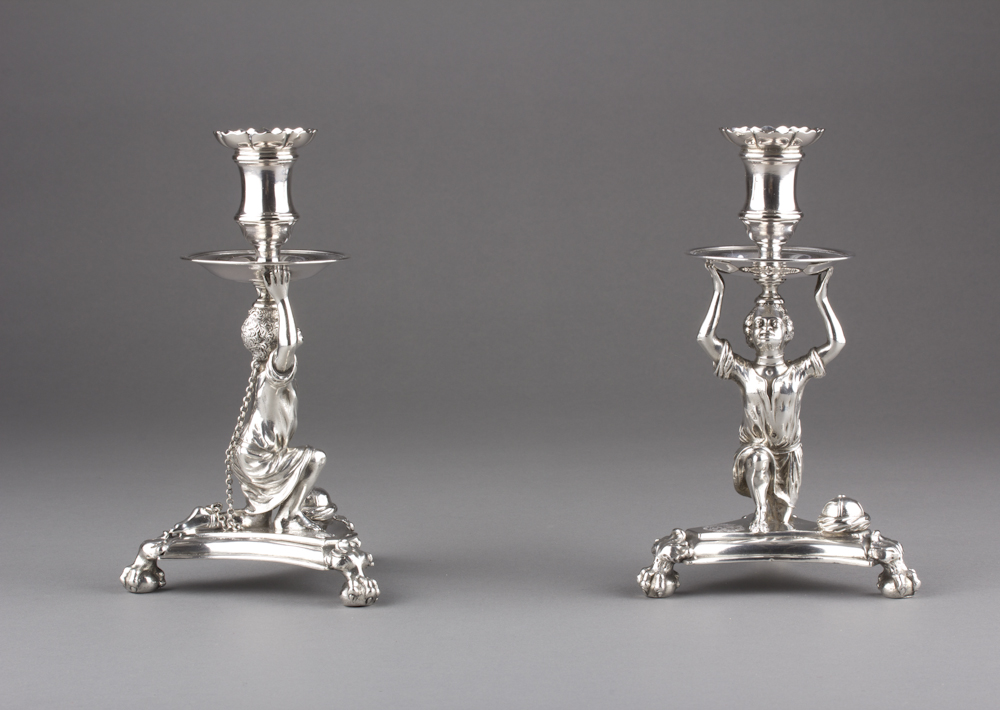
The National Maritime Museum, London, holds a silver gilt snuff box, made around 1740, with a painted ivory panel set inside the lid which shows a young male African. He is dressed in livery and wears a silver collar.
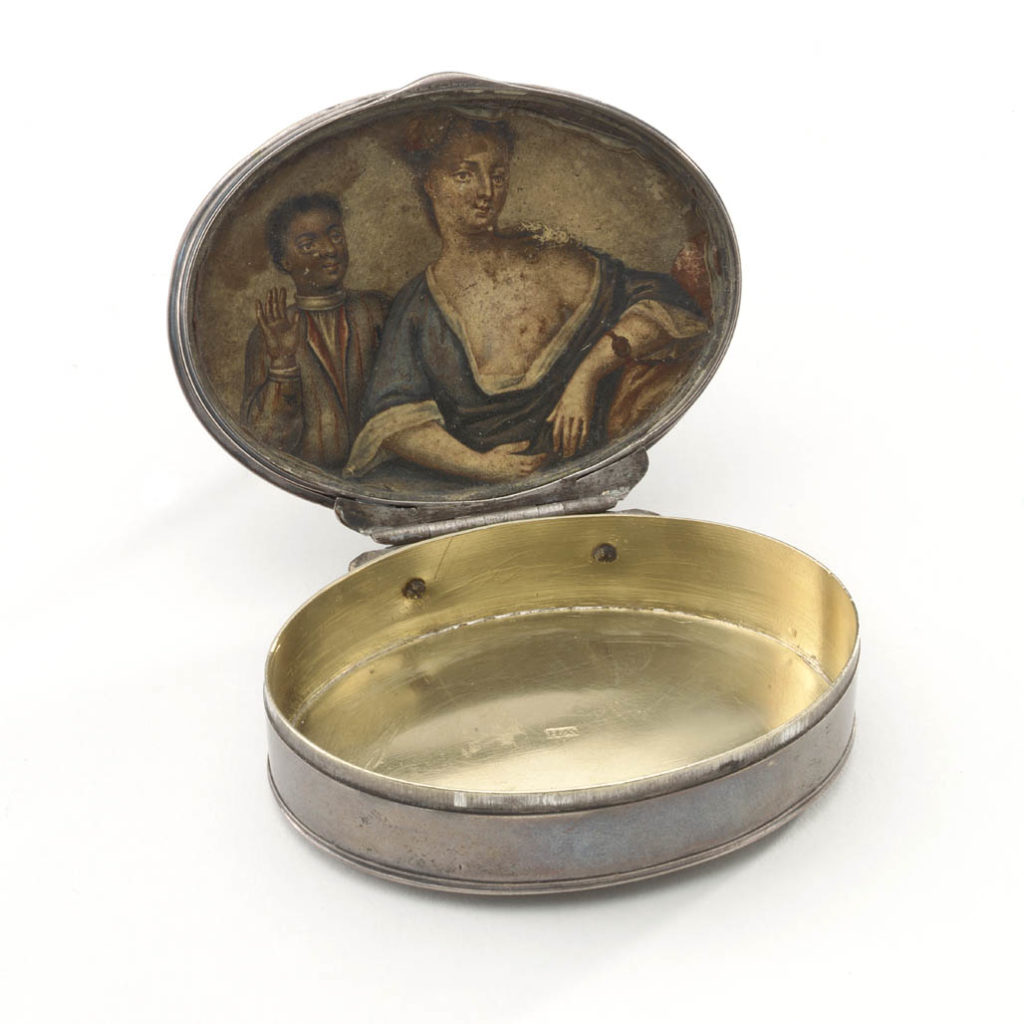
Even in those items where a slave collar was not evident, such as in the slew of ‘Blackamoor’ porcelain manufactured in the early to mid-eighteenth century, the depictions, as Adrienne L. Childs observes, also ‘presented the idea of black servitude as normal, natural or charmingly exotic’.
As these representations may have been the only or rare representation of the Black person in the homes of the upper classes they cemented the idea that the Black person’s normal role was one of servitude.
It is especially concerning in light of this context, therefore, that the Black page was not mentioned by the Room Guide at Petworth. It suggests that the Trust has more work to do in honouring its public commitments. A survey of its listings reveals that it also has more to do in how it lists its collection with reference to slavery.
The National Trust, Black presence and slavery
In the subject ‘Black presence’, 31 of the 117 materials are images (paintings or mezzotints) with Black attendants (sometimes named in the description as ‘servant’, ‘groom’ or ‘page’) (see Appendix). Unfortunately, not all of the Trust’s materials with a Black presence are listed in the category ‘Black presence’ – as can be seen in the record for Hogarth’s A Harlot’s Progress: Quarrels with her Jewish Protector (1732 – 1755), Ascott Estate, Buckinghamshire, even though the painting includes a Black page. This is a surprising omission, not least because, as Professor David Dabydeen noted, ‘William Hogarth was the most prolific painter and engraver of blacks. They figure in each of his major satirical series, from the Harlot’s Progress of 1732 to the Election pictures of the 1750s’ (p. 9).
In only one of the images in the category ‘Black presence’ in which the Black attendant wears a slave collar is the enslaved status of the attendant mentioned in the title of the image: Mary Helden (1726 – 1766) and an Enslaved Child (mentioned earlier in this essay).
The painting is in the National Trust collection at Spriver, Kent. It was painted in 1739, when Mary would have been 13. The National Trust’s summary of the painting notes:
A label, written by Christie’s when it sold on 15 October 1940, is on the reverse of the portrait. It reads ‘Mary, daughter of John Helden of Egham [& St Kitts], wife of Thomas Foster, elder son of Colonel John Foster, in white satin dress, standing on a terrace, her negro page Sambo and a dog by her side’.
It is not clear from the National Trust record whether this information alone led the Trust to include in the title of the painting ‘and an Enslaved Child’ or whether these words were in the original title. If the latter, no further information is publicly available to confirm that this is the case. The Trust’s summary simply adds: ‘At left a child, wearing a slave collar, light green livery, red breeches, a white turban and pearl earring, holds a tray of fruit and looks up at the woman.’
In six of the remaining ‘Black presence’ images listed in the Trust’s collection in which the attendant clearly or apparently wears a slave collar this fact or a statement that the metal collar is indicative of enslavement is mentioned in the description produced by the National Trust. This can be seen in The Hon. Anne Howard, Lady Yonge (d.1775) and a Page and Captain Thomas Lucy (circa 1655-1684) and an unidentified groom, both mentioned earlier in this essay.
However, in two images where the attendant clearly or apparently wears a slave collar, the apparent enslavement of the child is not mentioned by the National Trust. In A Lady in Pink and an Attendant, style of Sir Peter Lely (circa 1600-1699) (below), in the Trust’s collection at Snowshill Manor and Garden, the description refers to an ‘attendant of African descent’ but does not refer to what appears to be a slave collar around his neck.

Similarly, in The Hon. Anne Coventry, Lady William Savile, later Lady Thomas Chicheley (d. 1662) and Page, mentioned earlier, the description includes the statement: ‘her right hand held towards a young black chid [sic], half seen at the left, holding a bowl of fruit, wearing a silver collar and looking up at the sitter, whos [sic] left hand holds a flower in her lap.’
In some of the images it is not yet known if the artist painted the attendant from a model or if it is a portrait of a real person in the household of the principal sitter. The remainder of the images do not specify the Black attendant’s status, but it is probable that the attendant is not free. Almost all the images depict Black children.
It is a matter of concern that the National Trust does not refer fully to the significance of these collars in these two paintings. The Trust has done so for other paintings in its collection. The significance of the collar is certainly well-documented in academic literature over a long period, such as in the 1967 book Occupational Costume in England from the Eleventh Century to 1914 by Dr Phyliss Cunnington and Catherine Lucas.
Charles Seymour and the Black page in a context of right-wing attacks on the Trust
Returning to the portrait of Charles Seymour at Petworth, it’s possible to see how this context of Black attendants and slavery enables a fuller understanding of the presence of the Black page in that portrait and its broader significance within the collection. The representation of the page in the portrait is consistent with a clear pattern of representing the Black attendant in a visually subordinate arrangement. The page may or may not have been a real person serving Charles Seymour: he may have been included as a ‘type’ or ‘trope’ (and further research should seek to resolve this matter). But whether he was a real person or not, the absence of a slave collar does not necessarily mean that he is not a slave. Indeed, it is likely, given the widespread practice among the aristocracy at the time, that he was a slave or, if included as a trope, intended to represent the slave. The Guide’s omission of the Black page also abandons the opportunity to engage in consideration of the status of the page, the likelihood of his enslavement and how this connected to a broader economy, culture and politics.
The depiction of the lavishly dressed domesticated Black ‘servant’ during the late-sixteenth century through mid-eighteenth century typically obscured the violence of slavery outside the frame of the painting; including the abduction from one’s home, the multiple dislocations from culture, family, friends and loved ones, the terrifying forced transportation in inhumane conditions, the exposure to brutalisation (including rape and sexual abuse), illness, and early death. It is possible that the images also help trouble a complacent and too-neat separation, as evident in the work of Professor Kate Lowe, between the assumed ‘legal’ status of such servants and their ‘social’ status when she writes: ‘In group scenes involving both white and black people, black Africans often appear in very marginal or liminal positions, but once again this cannot be taken as an indication of legal rather than social status’ (p. 19).
Despite the comforting shibboleth that the law of England did not allow slavery, it is necessary to recall that slavery was not abolished until the Slavery Abolition Act 1833. With reference to the fashion for a Black child attendant, it is worth recalling that it was not uncommon to see long before the abolition movement numerous advertisements in English newspapers for the sale of Black children, with explicit reference to their skin colour; as illustrated in the Daily Courant, 20 November 1719, p. 2: ‘There is a Negro Boy of 8 or 9 Years old, to be sold, of a very good black Complexion. Enquire at Mr. Perchard’s, Pewterer, the Corner of Abchurch-lane, Cannon-street’. Occasionally, advertisements would seek deep Black complexion, as noted by Professor David Dabydeen: ‘Wanted immediately a Black Boy. He must be of a deep black complexion’ (p. 30, from Williamson’s Liverpool Advertiser, 20 April 1756). These are aside from the many more notices in those English newspapers regarding runaway slaves.
The much-feted Somerset case in 1772, which was interpreted by some to mean that English law would not permit enslavement within England’s borders, stands for the much narrower authority that a slave could not be forcibly removed from England against his will.
Those advertisements and notices in English newspapers probably point to a different reality for some, if not many, Black attendants. There were unquestionably some free Black people in England before the Act of 1833 but there also appear to have been enslaved Black people in the country. Prior to 1833, how would an enslaved Black person seek to vindicate any belief in their liberty? If they ran away, they would most likely have been tracked down and returned to their ‘master’ and punished, or abducted and sold – probably surreptitiously – into slavery abroad to avoid any risk their ‘master’ would find them. Even if the Black person’s English was passable and even if they had the opportunity to seek advice, they may have been betrayed. It is unlikely that many would have been able to afford a lawyer. It is possible that some were able to flee the country but their options were vanishingly small and fraught with risk. The paintings of the Black attendant are important artefacts. They require further research to help better understand the liminality between enslavement and servitude and associated malleable understandings of law at the time.
It is possible that too much might be inferred from the omission by the Room Guide at Petworth regarding the page in that portrait of Charles Seymour. Indeed, it is possible that the Guide, like others, sees but does not record the page and that this serves the purpose of the painting. This apparent paradoxical effect is taken up by Professor Peter Erickson in writing about such Black servants in these paintings:
‘The portrait is of the white patron; the servant is secondary but nevertheless “portrayed”. This portrayal is shaped by paradoxical inter-relations between visibility and invisibility. The purpose of the role is display: hence the servant is a prominently visible object. Yet the display is simultaneously meant to signal a seen-but-not-heard subservience; hence the servant is invisible as subject. The requirement that the servant be both conspicuous and unobtrusive creates an awkwardness amounting to a built-in tension. This difficulty is managed through visual filters designed to produce a selective visibility within a narrow range and to promote acceptance of the servant’s status as visible yet not visible.’ (p. 4)
This production of a selective visibility/ invisibility may also explain the admission by Professor Patricia A. Matthew of seeing a similar picture but not noticing the Black attendant. It would also be unfair to single out one Guide for an isolated incident, and I have deliberately withheld details that might identify the individual concerned.
It is also possible that the vituperative and sometimes emotionally fraught language directed by some on the political right at the National Trust following publication of its preliminary report on colonialism and slavery might understandably make some of its volunteer guides anxious about answering questions from an unknown white, middle-aged man (such as myself) about one of the items with Black presence in its collection, especially where that item is or might be linked to colonialism and slavery.
Take, for example, the reaction of Charles Moore, Baron Moore of Etchingham, former editor of right-wing periodicals, The Spectator, The Sunday Telegraph, and The Daily Telegraph, to the Trust’s approach. He described England’s stately homes as places of refuge and relaxation for millions of people. “I think comfort does matter,” he said. “I know, people say that ‘oh, we must be uncomfortable’…“Why should I pay a hundred quid a year, or whatever, to be told what a shit I am?”’
Others criticising the Trust included current and former Conservative MPs, such as Andrew Bridgen MP and Ann Widdicombe – who announced she had cancelled her National Trust membership over what she termed ‘these sorts of woke games being played’. Oliver Dowden, then Culture Secretary, joined the criticism of the Trust, calling on it to focus its efforts on ‘preserving and protecting’ Britain’s heritage. A group of right-wing MPs and Lords came together as the Common Sense Group and lambasted the Trust.
The attacks were expanded towards the end of 2020 to include the Trust’s collaborative work with Professor Corinne Fowler, University of Leicester, on the Colonial Countryside project; a child-led writing and history project exploring the African, Caribbean and Indian connections at eleven of the Trust’s properties. There followed what appear to have been coordinated attacks in The Daily Mail, The Spectator, The Daily Telegraph, and Express against the Trust and academics who had worked with the Trust on colonialism and slavery. Some of these attacks were personalised, with a number of men specifically singling out and threatening Hilary McGrady, Director-General of the Trust, Professor Fowler and other female academics.
This right-wing uproar also led the Charity Commission, the regulator of charities in England, to open a regulatory compliance case in September 2020 to determine whether the Trust had acted in accordance with its charitable objects. The Commission, which was criticised for politically biased interference, subsequently concluded, unsurprisingly to those of us with clear-eyed views about both the manufactured outrage by some on the political right and the law, that the Trust had acted within its powers.
Yet, the omission by the Guide at Petworth to mention the Black page is not the only such omission by the Trust in mentioning Black presence, as noted earlier in relation to Shawn Sobers’ account of the visit to Dyrham Park and as evident in the silences around enslavement in some of the Trust’s descriptions of paintings in its collection. Nor are these omissions inconsistent with similar gaps, disappearances or erasures of Black presence in dominant White versions of history more broadly.
Seeing and seeking to understand the Black page
Thankfully, this partial history is now increasingly challenged, certainly in Britain, through a considerable body of work by Black scholars and artists. This scholarship includes recent general histories such as David Olusoga’s Black and British: A Forgotten History, and work focusing specifically on Black presence in art, such as Paul Gilroy’s Picturing Blackness in British Art: 1700s – 1990s.
The responses by artists include Lubaina Himid’s Naming the Money, an art installation first displayed in 2004. Consisting of one hundred life-size painted cut-out figures and a soundtrack of brief stories about the subjects set against slow, reflective orchestral music, seeks to redress this erasure, including of the personality, hopes and aspirations of these Black attendants. The installation reveals part of hidden histories of Black slaves and servants. It also gives these forgotten individuals a voice.
Recent exhibitions elsewhere, notably Figures of Empire: Slavery and Portraiture in Eighteenth-century Atlantic Britain at the Yale Center for British Art, 2014, HERE: Black in Rembrandt’s Time at The Rembrandt House, Amsterdam, 2020, and the new display centred on The Portraits of the Deurbroucqs at Musée de l’Histoire de Nantes, in France, also seek to redress these omissions.
Notwithstanding the National Trust’s promised ‘commitment to research, interpret and share the histories of slavery and the legacies of colonialism’ at its properties, it would appear that it has since re-evaluated its approach. Following the backlash from the hard-right, particularly to the Trust’s preliminary report on colonialism and slavery, John Orna-Ornstein, Director of Culture and Engagement for the National Trust, explained to Sam Knight that the Trust had conducted “a season of listening,” talking to its members and people inside and outside the organization, and adopted a new approach, called Total History, that would try not to privilege one type of story over another. The Trust also decided not to support an academic-funding proposal that would have followed up the preliminary report on its properties. “I wanted to pause,” Orna-Ornstein told Knight. “I can see why it feels as though we’re sort of turning away from this, in some sense. I don’t think we are at all.”’
Given this change of approach, it is perhaps unsurprising that omissions about Black presence remain prevalent at the Trust; in summaries and descriptions of artworks and apparently in the training given to their volunteer room guides. It is unfortunate. Scholars, artists and curators elsewhere show that there can be another way, one that seeks to fully address history and stands up to those who would be content to maintain the silences about the effects of colonialism and slavery.
__________________
.
Appendix
Images (paintings, prints or mezzotints) with Black attendants (including servants, grooms and pages) listed in ‘Black presence’ of National Trust collections.
Key: Title. Date, Artist, National Trust collection.
1. John Delaval (1756-1775) as an Archer and an Attendant. circa 1770, William Bell, Seaton Delaval Hall, Northumberland.
2. Confidence. Unknown, unknown, Fenton House, London.
3. In Regency Times. circa 1940-circa 1970, after Doris Clare Zinkeisen, National Trust Carriage Museum.
4. John Manners, Marquess of Granby (1721-1770), after Sir Joshua Reynolds. Unknown, after Sir Joshua Reynolds PRA, Belton House, Lincolnshire.
5. Sancho Panza and the Duchess (from Cervantes’s ‘Don Quixote of La Mancha’ [1605-15]). 1824 (exh at RA), Charles Robert Leslie, Petworth House and Park.
6. The Hon. Anne Coventry, Lady William Savile, later Lady Thomas Chicheley (d. 1662) and Page. 1660, attributed to John Hayls, Lyme. Cheshire.
7. Margaret Brownlow (1687-1710) and an unidentified attendant. 1695, Henry Tilson, Belton House, Lincolnshire.
8. Louis-Philippe-Joseph, Duke of Orleans ‘Philippe Egalité’ (1747-1793) (after Sir Joshua Reynolds). Circa 1786, John Raphael Smith, Nunnington Hall, North Yorkshire.
9. Laura Dianti and a Page. 1500-1599, after Titian, Hatchlands Park, Surrey.
10. John Manners, Marquis of Granby (1721-1770) (after Sir Joshua Reynolds). circa 1766 -circa 1770, James Watson, Calke Abbey, Derbyshire.
11. Lamprey (A Racehorse). circa 1723-1728, John Wootton, Tredegar, Newport.
12. Mars, Venus and an Attendant derobing her Mistress for the Bath. 1839-1840 (exh at RA), Anglesey Abbey, Cambridgeshire.
13. The Hon. Anne Howard, Lady Yonge (d. 1775) and a Page. 1737, John Vanderbank the younger, Sudbury Hall, Derbyshire.
14. Louis-Philippe-Joseph, Duke of Orleans ‘Philippe Egalité’ and Groom (1747-1793) (after Sir Joshua Reynolds). 1785, Samuel Drummond, Petworth House and Park.
15. The Rape of Europa. 1687-1688-1691, Charles de la Fosse, Basildon Park, Berkshire.
16. William Cavendish, 1st Duke of Devonshire, 4th Earl of Devonshire, KG, PC, (1640-1707) and an Attendant. 1697, attributed to John Closterman, Hardwick Hall, Derbyshire.
17. Captain Thomas Lucy (circa 1655-1684) and an unidentified groom. 1680, Sir Godfrey Kneller, Charlecote Park, Warwickshire.
18. Charles Seymour, 6th Duke of Somerset KG (1662-1748) and a Page. circa 1690 – 1692 (payment), John Closterman, Petworth House and Park.
19. Mary Helden (1726-1766) and an Enslaved Child. 1739, Charles Phillips, Sprivers, Kent.
20. Probably John Arundell, 3rd Baron Arundell of Trerice (1678-1706) as a Boy and an Attendant. 1680-1688, Casparus Smits or Smitz (Gaspar Smith), Trerice, Cornwall.
21. Lady Elizabeth Wriothesley, Lady Elizabeth Noel (d.circa 1680) and an Attendant. 1660-1665, Sir Peter Lely, Petworth House and Park.
22. Thomas Smith (1699/1700-1744), his Family and an Attendant. 1733, Robert West, Upton House, Warwickshire.
23. An Unknown Lady as a Shepherdess and an Attendant. 1662-1707, Casparus Smits or Smitz (Gaspar Smith), Blickling Hall, Norfolk.
24. Cleopatra dissolving the Pearl in Wine. 1725-1784, Andrea Casali, Upton House, Warwickshire.
25. Two Children and an Attendant. 1658, Anglo-Dutch School, Oxburgh Hall, Norfolk.
26. A Lady in Pink and an Attendant. 1600-1699, style of Sir Peter Lely, Snowshill Manor and Garden, Gloucestershire.
27. Princess Henrietta Anne Stuart, Duchess of Orléans (‘Minette’) (1644-1670) and an Attendant. 1700-1799, after Jean Charles Nocret, Dunham Massey, Cheshire.
28. The Belton Conversation Piece. circa 1725 – circa 1726, Philippe Mercier, Belton House, Lincolnshire.
29. John Delaval (1756 – 1775) as a Boy and an Attendant. 1770, William Bell, Seaton Delaval Hall, Northumberland.
30. Lieutenant, later Captain, Paul Henry Ourry, MP (1719-1783) with ‘Jersey’. 1748, Sir Joshua Reynolds, Saltram, Devon.
31. Six of the Duke of Newcastle’s Manège Horses. circa 1665 – circa 1675, Anglo-Flemish School, Wimpole, Cambridgeshire.
__________________________
I’m afraid that any academic in an institution in receipt of public funds who doesn’t have the moral decency, in an age of widespread electronic publishing, to publish their work or a sufficient part of their work freely online to enable the taxpaying public to view any work salient to this essay won’t get cited if I cannot locate that work in full or in sufficient part online. Too many academics traduce their public obligations by publishing their work behind paywalls erected by price-gouging publishers that perpetuate elitist, non-egalitarian editorial arrangements and models of publishing. For the record, the following academic has, therefore, not been cited in this essay:
Elizabeth McGrath, FBA, Emeritus Professor and Honorary Fellow at the Warburg Institute, School of Advanced Study, University of London, and sometime Slade Professor of Fine Art at the University of Oxford.
In this essay, those references which I cite in the body of the essay are linked to publicly accessible publication of the whole or part of the reference material. Sometimes, publicly accessible material is available in different portions on different websites online. As a hyperlink can only link to one website, it might be worth checking other websites. Google, for instance, will sometimes include chapters from books (though can omit pages within chapters). Amazon will sometimes include the introduction to a book. Occasionally, entire books can be accessed free online.
.
© Dermot Feenan 2021
.
Update: 16 November 2022
The National Trust amended its webpages after publication of this essay. In summary, the relevant changes are as follows:
The painting previously titled ‘The Hon. Anne Coventry, Lady William Savile, later Lady Thomas Chicheley (d. 1662) and Page’ is retitled ‘The Hon. Anne Coventry, Lady William Savile, later Lady Thomas Chicheley (d.1662) and an Unidentified Enslaved Child’.
The description of this painting has also been amended, and now includes a ‘Note on the Unidentified Enslaved Child’ which states: ‘That the attendant figure is a child of African descent wearing a metal collar indicates he was enslaved. It is not known if the child was included by the artist as a trope or as a portrait of a real individual.’
The category ‘Black presence’ now yields a record for Hogarth’s A Harlot’s Progress: Quarrels with her Jewish Protector.
The title of the painting of Charles Seymour, 6th Duke of Somerset, has also been amended to ‘Charles Seymour, 6th Duke of Somerset KG (1662-1748) and an Unidentified Child Attendant’. The summary of the painting now includes a ‘Note on the Unidentified Attendant’ that acknowledges that ‘he may be enslaved’.
Credit to the Trust for making the aforementioned changes, especially against a backdrop of unreasonable challenges elsewhere to its ongoing commitments and work. Special thanks to the Trust’s Curatorial & Collections Director with whom I shared my essay.
Corrections
The essay was corrected on 27 September 2021 to take account of several typographical errors. Those corrections do not affect the substance of the essay.
One sentence was deleted during these corrections. On reflection, that sentence could have inadvertently suggested that use of the trope of enslavement in a painting might be more serious than portrayal of an actual enslaved person. The sentence had not been well thought through when it was first included. I had intended to suggest that use of the trope is also important. The use and implications of the trope is one that I will be considering further in future work on the Black attendant. The deletion of that sentence does not significantly affect the meaning of the rest of the essay.
Apologies for any inconvenience caused by these corrections.
A revealing piece of writing. Thanks Dermot. I learned a lot.